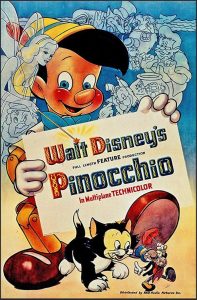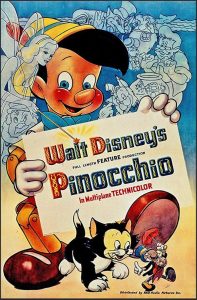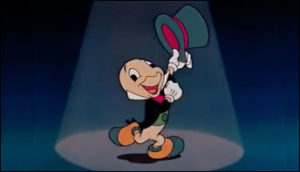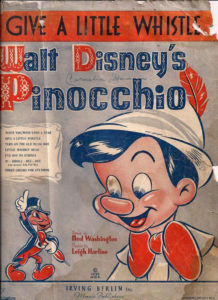
 In their book, The Disney Villain, authors and legendary Disney animators Frank Thomas and Ollie Johnston discuss a scene from Pinocchio:
In their book, The Disney Villain, authors and legendary Disney animators Frank Thomas and Ollie Johnston discuss a scene from Pinocchio:
“Historian, author, and critic John Culhane said the most upsetting moment in the whole picture for him was when the Coachman was testing each new donkey to see if any remnants of the boy remained. He asked one donkey what his name might be. The trembling voice replied, ‘Alexander.’ The gruff coachman flung him aside, yelling, ‘This one can still talk! Put him back!’ John moaned, ‘I have worried about that kid my whole life.’”
This memory of Pinocchio, from Culhane, a legend as well, is reminiscent of those from so many who have seen Walt Disney’s animated masterpiece since it first debuted eight-five years ago today, on February 7, 1940.
The film is one of those rare films that has become a significant part of film history, art, pop culture, and impactful childhood memories.
The follow-up to the Disney Studio’s first landmark animated feature, 1937’s Snow White and the Seven Dwarfs, Pinocchio was another expansion of the art form, showcasing all the immense talents of the Disney artists.
Walt bought the rights to Pinocchio in 1934. It’s claimed that animator Norm Ferguson is the one who brought the story to Walt’s attention.

Written by Italian author Carlo Collodi and published in 1883, the original Pinocchio was a much darker, at times violent, story that would be tailored for its translation as a Disney animated feature.
The film tells the epic and episodic tale of the title character, an innocent puppet boy, who a magical Blue Fairy brings to life for the kindly Geppetto, the woodcarver who created Pinocchio. With his “conscience,” Jiminy Cricket, at his side, Pinocchio sets off for school and finds himself on an adventure that leads him to the villainous puppet master Stromboli, the eerie realm of Pleasure Island, and a finale in the belly of the whale Monstro.
 Throughout all of this, Pinocchio is a true spectacle. No matter how often one has seen it, there is so much to marvel at.
Throughout all of this, Pinocchio is a true spectacle. No matter how often one has seen it, there is so much to marvel at.
The Disney animators’ mastery of personality animation is on full display here. There’s the innocence of Pinocchio, brought to the screen by Thomas and Johnston, along with fellow legend Milt Kahl; the warmth of Geppetto, which came from the brilliance of Art Babbitt; the swagger of Lampwick (the cocky young boy Pinocchio meets on Pleasure Island) that springs off the screen, thanks to the genius of Fred Moore and the immense power of Monstro the whale, in one of films most kinetic action sequences, courtesy of Wolfgang Reitherman.
Each dynamic performance demands attention as soon as they appear on screen.
As does the explosive Stromboli, who was memorably animated by Vladimir “Bill” Tytla (who would also, incredibly, animate Chernabog in Fantasia, released the same year). Noted author, animation historian, and Oscar-winning animator John Canemaker curated an exhibit of Tytla’s work at New York’s Katona Museum of Art in 1994.
In an interview at the time of the exhibit’s opening, Canemaker noted of Tytla’s work on Pinocchio, “Stromboli is an incredibly strong and powerful character. One of the most three-dimensional of Disney’s villains. He could charm you and seem to be funny, but he’s unpredictable.”
 Then, there is Ward Kimball’s work on Jiminy Cricket. When creating the character, Kimball wisely jettisoned any ugly, insect-like appearance, and the result was one of animation’s most famous characters, serving as host, narrator, and, yes, conscience for the audience.
Then, there is Ward Kimball’s work on Jiminy Cricket. When creating the character, Kimball wisely jettisoned any ugly, insect-like appearance, and the result was one of animation’s most famous characters, serving as host, narrator, and, yes, conscience for the audience.
So well received was Jiminy Cricket, a breakthrough star, that he went on to be featured in the 1947 package film Fun and Fancy Free, and later on, The Mickey Mouse Club and educational films. Through the years, Jiminy has also emerged, along with Mickey Mouse and the gang, as somewhat of a spokesperson for Disney.
In addition to Kimball’s work, a big part of Jiminy Cricket’s connection with audiences came from the voice of Cliff Edwards, a popular singer nicknamed “Ukulele Ike.” Edwards provided a genial vocal performance that paired perfectly with the character.
Along with Edwards, Pinocchio’s cast was filled with talented character actors and comedians, such as young Dick Jones as Pinocchio, Christian Rub as Geppetto, Walter Catlett as “Honest” John, the fox who tricks Pinocchio out of going to school, Charles Judels as Stromboli, Evelyn Venable as the Blue Fairy, and Frankie Darro as Lampwick.
Also, the one and only Mel Blanc, best known for his iconic Looney Tunes character voices at Warner Bros, was initially cast as Gideon, the dim-witted cat who is the sidekick of “Honest” John. Blanc recorded the dialogue for the character, and then it was decided that Gideon wouldn’t speak. All that remains in Pinocchio of Blanc’s performance is a hiccup.
 The backdrop for these characters are some of the most stunning moments in Disney animation. Illustrator Gustaf Tenggren, who created beautiful conceptual artwork during Pinocchio’s early production days, inspired the film’s style.
The backdrop for these characters are some of the most stunning moments in Disney animation. Illustrator Gustaf Tenggren, who created beautiful conceptual artwork during Pinocchio’s early production days, inspired the film’s style.
Directors Ben Sharpsteen and Hamilton Luske partnered this artwork with the technology of the Multiplane Camera to give scenes in Pinocchio additional depth and dimension, usually found in live-action films. This is especially seen in a brief yet striking sequence where the camera seemingly “swoops” through Geppetto’s village as the residents emerge from their homes to start the day.
Then, there are the songs by Leigh Harline and Paul J. Smith, each setting perfectly in the story and finding life beyond the film. They include “Give a Little Whistle,” “Hi-Diddle-Dee-Dee,” “I’ve Got No Strings,” and the Academy Award-winning “When You Wish Upon a Star,” which would go on to become an anthem for the Disney Company. (For more on the music of Pinocchio, check out Greg Ehrbar’s 2015 Animation Spin article).
The song, like the film, contains messages of hope and faith. As Pinocchio celebrates its 85th anniversary, it’s easy to see why generations have enjoyed this wonderful film, passed it down to subsequent generations, and, like Mr. Culhane, still worry about poor Alexander from Pleasure Island.





